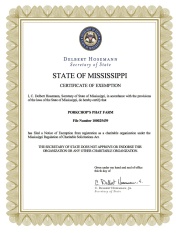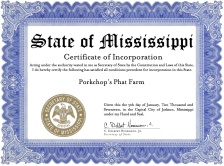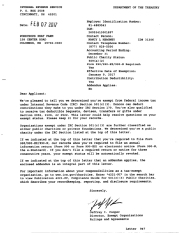Just the Facts, Please
This is excerpted from a brochure written by Helen Morrison
for Pigs As Pets, Inc.
- Potbellied pigs are clean, intelligent, affectionate creatures.
- Pigs are the fourth smartest animal group on the planet, following only humans, apes and chimps,whales and dolphins.
- Their intelligence, curiosity and charm make them appealing, but it may also make them a challenging pet.
- Pigs have special needs. They make wonderful pets for those people who understand their special needs and are willing to educate themselves and meet those needs.
- They require extra patience and perseverance, but it is more than made up for by their wonderful personalities!
SIZE
- All potbellied pigs are miniature in relationship to their cousins, the farm hog.
- Farm hogs can grow up to 900 pounds or more.
- Pigs have dense compact bodies, especially when compared to dogs or people.
- A 150-pound pig is much smaller than an 80-pound German shepherd or a 100-pound person. A 150-pound pig is not as big as one may imagine!
- A typical, full grown, potbellied pig can be anywhere from 100 to 250 pounds.
- The largest registered potbellied pig is over 400 pounds (not recommend for the health of any pet pig). As with people, the size varies, but the average size is somewhere between 100 and 150 pounds, being less than 20 inches high at the shoulder.
- Pigs grow quickly until they are about one year old, then continue to grow slowly until they are between three and four years old. So, that 10-pound baby piglet will grow into a 100-pound or more adult -- don't believe anything else!
WATER
Drinking Water
Ever hear of the phrase "sweat like a pig"? Well, pigs do not actually have sweat glands. Pigs cannot sweat! This means they need plenty of fresh water available at all times to prevent
overheating.
Male pigs can be prone to urinary tract infections and other disorders. Make sure all male pigs have plenty of fresh water available at all times and that they drink it.
If your pig seems reluctant to drink water, add a little fruit juice (like apple juice) or some Gatorade or similar sports type drink to the water. Just enough to add flavor usually does the
trick.
For Health and Safety
Pigs keep cool by splashing in water or rolling in mud. Give your pig a child's plastic swimming pool filled with a few inches of water. Some pigs are afraid to step into the pool for the first time,
so you may want to throw a few grapes or
apple chunks into the pool to entice the pig. Cut a little "doorway" in the side so the pig can step in easily.
INDOOR LIVING
- Yes, pigs generally make good house pets!
- All pigs root. It the natural instincts of the pig, its how they find food in nature.
- You would not want to prevent a human baby from learning to walk, so why prevent your pig from rooting! It does not mean you allow the pig to root your entire house.
- Instead, give the pig plenty of outside time in a secure run or take long walks so they can root outside. Or, make a rooting box filled with rocks or small to medium hard rubber balls. Sprinkle a couple of treats in the box to teach the pig what it's used for. You can also sprinkle some Cherrios or pieces of carrot, popcorn, etc., into a large pile of blankets to teach the pig to root in it's blankets.
- Pigs are intelligent, curious animals. You will need to pig proof your home, just as you would baby-proof your home for a toddler. Some people will clear off a lower shelf or two, well within reach of the pig's snout and put piggy toys there.
- The pig will quickly learn to take toys off its shelf only, making a happy pig and happy people. Pigs often watch where their food comes from, so they can learn to open cabinets and even the refrigerator! Plants may also need to be put up in high places, so they are not eaten or spilled all over your floor.
Indoor Housing
Your pig will need a soft bed of blankets or pillows. All pigs need a "place" of their own to hide when they are feeling insecure or want to be left alone. This can be a quiet room, a closet or a
large animal crate in a corner. You may also
want to teach your pig to sleep in a crate or separate room.
Someone once wrote a 10-pound pig in the bed is cute, a 100-pound pig may not be!
Potty Boxes
In cold or rainy weather indoor pigs may not want to go outside to potty. If you choose to use an indoor potty box, select one with low sides or cut down an entrance. Pigs don't like to step up and
over something to use the potty. The box
must be big enough for the pig to turn around in. If the bottom of the box is slippery put a no slip mat in the bottom, under the litter.
Avoid using clay litter, as pigs may inhale it (causing pneumonia) or eat it (causing intestinal blockages), both which could be fatal. Pine shavings are inexpensive, old towels can be used, adult
diapers or underpads make good box liners too and are easy to wash or dispose of. Cedar is not recommended.
Pigs learn to potty in a particular spot. Choose the potty box location carefully because the pig may not want to change potty spots later. When a pig is very small, take him to the box every hour or
at least every two hours when he is
awake, as soon as he wakes up and right after he eats or drinks. If you are not home to closely supervise the pig, you can also confine the pig to a small area with its bed and potty box separated as
much as possible. The pig will not use its
bed as a potty box, so it will learn to use the litter box. Or, you can put some of the pig's poop into the box, once the pig smells it; it should start to use the box.
Do not give the pig free, unsupervised run of the house until he is at least 6 months old. Pigs younger than that are prone to accidents!
If the accidents are not caught and corrected immediately, housebreaking will be more difficult. If a pig does something once, he remembers. If he does something twice, it’s a habit. If he does it
three times, you may be out of luck!
Close supervision and proper housebreaking early on will help avoid problems in the future.
If you catch a pig making a mistake, take him to the litter box and let him finish pottying in the proper place, then praise him. Clean up the mess with a commercial deodorizer made for removing pet
odors or vinegar and baking soda.
Clean up is important to avoid future accidents in the same spot -- pigs have strong noses and good memories!
If possible, put a heavy piece of furniture in that spot or a bath mat and the pig's food dish and feed him there for a few days. Pigs do not eat and potty in the same places!
After a week or so clean the spot again. Wait a few more days and when the pig is not looking sprinkle some food or a couple of treats in the area. The pig will think the treats sprout from the rug
or floor and will not want to potty there again.
OUTDOOR LIVING
Outdoor Housing
Outdoor pigs need a sturdy, rainproof shed, barn or doghouse. In cold climates, it must also be wind proof and have enough room for plenty of straw and blankets to keep the pig warm. Ideally outdoor
pigs should be kept in small groups for extra body warmth. Remember pigs need plenty of fresh water at all times. In hot weather they need a small pool or mud puddle to keep cool. In cold weather, be
sure not to let their water freeze.
Outdoor Runs
It is not recommended that a pig be kept full time in a run or pen with a cement floor. The pen should give the pig plenty of room to move around, a place for its potty area away from it's housing
and food areas. We like pens no smaller than
8' x 16', with access to areas outside the pen for exercise or a 16 x 16 foot pen (which is the length of the standard hog panels!).
Pigs don't jump high, but they do like to root & dig. A 4-foot high fence wills easily keep your pigs in, but will not keep an aggressive dog or other animal out. If you live in an area with
stray dogs or other roaming animals and creatures (i.e. kids),
you may wish to choose a 6-foot fence.
Hog panel (available from your local farm store) is the best and probably most inexpensive and secure fencing material. These panels are used by commercial hog farmers and are good and sturdy, for making sure the pig stays in its pen.
Chain link fencing reinforced with chicken wire at the bottom may also make a suitable pen, but BE SURE there is no place a pig's snout can get stuck, caught or injured. Pigs are curious and will
root and look for holes and ways to move the
chicken wire. To be sure the pen is completely secure, you should dig a trench about 1 foot deep just inside the chain link fence. Fasten the chicken wire to the lower 6' of the fence and extend it
down into the trench. Fill in the trench, burying
the wire. You can also put boards into the trench, bury part of the board, and fasten them to the fencing to secure the bottom.
Picket or split rail fences will NOT keep a pig in, but you can attach a hog panel to the fence to secure it. That makes an attractive as well as secure fence! A board on board fence will keep a pig
in, but may require reinforcement at the base, so a pig can't dig out beneath it.
TOYS
Whether indoor or outdoor, all pigs love toys, especially any toy with food. Old magazines, old shoes, old clothes (wear them so they have your scent and give them to the pig unwashed), infant toys,
dog or cat toys and balls are all good pig toys. Be careful, piglets can get caught in sleeves, buttons, snaps, etc.
Pigs also enjoy "Buster Cubes" (Petsmart.com) and Manna-balls (Pigstuff.com) filled with food or treats. Or you can make your own inexpensive version from a whiffle ball, 2-liter soda bottle or
plastic milk jug. Stuff the whiffle ball with plain air-popped popcorn, food pellets, frozen peas, etc. Or, punch holes in the soda bottle or milk jug, making sure they are big enough for the food to
fall out when the toy is pushed or rolled. Put the treat in the bottle or jug and the pig will push it around so the treats or food will fall out. For overweight or bored pigs, you may consider
feeding the entire food ration this way too -- it's good mental stimulus
and exercise!
HEALTH CARE
It can be difficult to find a vet willing and able to treat potbellied pigs. Potbellied pigs are NOT farm hogs. There are differences in their medical treatment.
Before allowing your vet to sedate your potbellied pig, be sure he knows the types of anesthesia to use and the amounts. The wrong drugs or dosages can be harmful or fatal to your pet. Isofluorane
gas is the safest, most effective type of anesthesia for a potbellied pig with the least amount of side effects
Pigs are also susceptible to Porcine Stress syndrome, a condition where the pig is so stressed out that he can literally drop dead. If your pig is "freaking" out for a sustained period of time (not
just for a few minutes when you pick him up), stop and let him calm down before continuing with whatever you are doing. Covering him up with a blanket will help to calm him down.
The most common potbellied pig health problems are diet related. Overweight pigs suffer from heart problems, blindness and arthritis. Underfed pigs (often in an attempt to keep them small) usually
die from malnutrition or complications from malnutrition.
Pigs need lots of fresh water at all times. Given water and the right diet, good housing and plenty of love, your pig should remain happy and healthy for many years.
Vaccinations
Potbellied pigs are susceptible to several contagious diseases. Even if you and your pig are never around other pigs, you should have your pig vaccinated every 12 months. Your vet should also check
you pig's eyes, ears, feet, tusks and
general appearance.
Most vets also include a dose of Ivomec along with the vaccinations to prevent worms and mange.
Pleurogard 4 covers: hemophiles, pleuro pneumonia, rhinitis and erysipelas
Respisure covers: microplasma pneumonia
Spaying and Neutering
- Every pet pig should be spayed or neutered.
- Male pigs are fertile as early as 2 months old. Intact male pigs do not make good pets, they tend to "hump" everything. Their mouths will foam constantly and they
- often "mark their territory" with a pungent smelling fluid.
- Intact females often get "PMS" and may forget their potty training while they are in heat. Generally females go into heat every three weeks. Also, intact female pigs have a very high incidence of life-threatening uterine tumors and infections when older and larger and no longer safe surgical candidates.
Eyes and Ears
Some pigs are prone to eye problems, so check our pigs eyes for irritation or stuck eyelashes, or eyelashes that may curve into the eye and cause irritation (entropian -- a condition that can be
corrected by surgery done by your vet).
Some pigs have naturally weepy eyes that produce sticky, brownish tears. Wipe away the goo with a soft, warm, damp cloth or baby wipes. You can also use a little Vaseline around the eye to keep the
brownish tears from caking on the pigs
face, it will also help to soften any brownish gook already caked there for easy removal.
Pigs sometimes get a brown waxy build up inside their ears - this is normal and does not mean your pig is dirty. Wipe the outside part of the ear gently with a soft cloth. Stay away from the ear
canal and inner ear. DO NOT try to clean deep
inside the ear. Do not flush the pigs ears out, liquid in the ear can cause deafness and balance problems. These procedures are best left for your vet.
Tusks and Hooves
All pigs grow tusks. Females grow small, sharp tusks that rarely stick out of their mouths. Neutered males will have a set protruding from their lips by age 1 1/2 to 2. Tusks do not have to be
trimmed unless there is a reason to do so. For
example, if the pig is around small children or if the tusks are bothering the pig. If your pig is calm and will allow it, you can gently file the tusks. If you pig is nervous, you can take your pig
to the vet to have the tusks trimmed.
Skin
All pigs have naturally dry skin (remember they don't have sweat glands like we do!) It's not necessary to bathe your pig on a regular basis. However it is fine to give him a bath when he gets
dirty.
Also, good brushing will help. Use any good lotion on your pig's skin as often as you like, which will help to keep the skin soft. Just be sure your pig is not allergic to it.
FOOD
Pigs like to eat! Pigs will do just about anything for food. If left to their own devices, pigs will overeat and quickly became obese. BUT, this does not mean you should starve your pig (see health
information above). It means your pig needs to eat wholesome food with limited treats (manufactured just for potbellied pigs, not commercial hog foods, dog foods or table scraps).
A pig's size (height & length) is determined by his genes, not by his diet (unless he is overfed and becomes overweight).
Underfeeding a potbellied pig will not "keep him small" and is simply cruel!
Your pig needs a food formulated especially for potbellied pigs, with no more than 14% protein. Never feed a pig dog food -- it is too high in fat, salt and protein.
Amount
The proper amount of food for your pig depends upon a lot of different factors. The pig's age, size, activity level and environment, for feeding guidelines go to www.rossmillfarm.com . Feed your pig
the proper amount at least twice a day.
Size and Age
The best way to determine if your pig is at the proper weight is to LOOK at him carefully. Make sure you can see his eyes.
Pigs with naturally plump faces overweight pigs may have extra fat deposits around their eyes making it difficult for them to see. Look down at him from above. His body should look like a cylinder
or a smooth tube. If he looks like he
swallowed a basketball, he may be overweight. Look at him from the side, he should have a nice belly but it should NOT drag on the ground.
Growing pigs (3 years or less) need more food than mature adults do. Larger pigs (that is, pigs with a naturally large bone structure, NOT overweight pigs with average bone structure) need more food
than smaller pigs.
Activity Level and Environment
Active pigs, pigs that travel frequently, regularly go on long walks or practice and perform tricks need more food than inactive pigs. Generally, indoor pigs get less exercise than pigs that stay
outside most of the time. Outdoor pigs with unlimited access to a large yard or very large run generally get more exercise walking around.
BUT, if the pig gets plenty of grazing or access to fallen fruits or acorns (acorns can be toxic to the kidneys when eaten in large doses) and grass, take this into account when determining how much
food and treats he needs.
Fresh Fruits and Vegetables
Supplement your pig with plenty of fresh, leafy vegetables. Iceberg lettuce is ideal because it helps the pig feel full, but has no fat and very few calories.
Some pigs are picky and won't eat everything.
Fruit and starchy vegetables (peas, corn, potatoes) can be fattening, so keep those to a minimum. Freeze grapes or cucumber slices for treats.
Generally 1 cup of fresh fruits and vegetables is fine for most pigs. If you pig spends the day grazing on your lawn or eating your flowers, cut back on this amount.
These types of supplements help to add variety to your pigs diet, but are not necessary to be fed everyday as long as you have the pig on a good quality potbellied pig food.
Treats
Pigs LOVE treats! But, be careful not to go overboard on the treats. Pigs will eat, as much as you give them and will act as if they are starving -- if you are feeding your pig properly, this is no
more than an ACT - don't give in!
Good treats are plain, air-popped popcorn, carrot slices, individual pieces of dry cereal (Cheerios or Chex). Remember to include the treats fed during training sessions when deciding how much food
your pig is getting -- those treats can add up!
Some people measure out a set amount of treats (say 1/4 cup for cereal) for a specified amount of time (1 - 2 days). This makes it easier to determine exactly how many treats the pig is getting.
Vitamins
You can give your pig one children's complete vitamin everyday.
If you have any questions or problems, contact:
Northwest Miniature Pig Association-NWMPA
P.O. Box 526
Aurora, OR. 97002
WWW.NWPETPIGS.ORG
503-253-8768
pattyrocs@msn.com
Pig Rescue Services and Placement
Patty Hill
9222 SE Mill St.
Portland, OR 97216
503-253-8768
pattyrocs@msn.com






